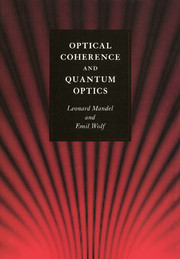Book contents
- Frontmatter
- Contents
- Preface
- 1 Elements of probability theory
- 2 Random (or stochastic) processes
- 3 Some useful mathematical techniques
- 4 Second-order coherence theory of scalar wavefields
- 5 Radiation from sources of any state of coherence
- 6 Second-order coherence theory of vector electromagnetic fields
- 7 Some applications of second-order coherence theory
- 8 Higher-order correlations in optical fields
- 9 Semiclassical theory of photoelectric detection of light
- 10 Quantization of the free electromagnetic field
- 11 Coherent states of the electromagnetic field
- 12 Quantum correlations and photon statistics
- 13 Radiation from thermal equilibrium sources
- 14 Quantum theory of photoelectric detection of light
- 15 Interaction between light and a two-level atom
- 16 Collective atomic interactions
- 17 Some general techniques for treating interacting systems
- 18 The single-mode laser
- 19 The two-mode ring laser
- 20 The linear light amplifier
- 21 Squeezed states of light
- 22 Some quantum effects in nonlinear optics
- References
- Author index
- Subject index
7 - Some applications of second-order coherence theory
Published online by Cambridge University Press: 05 April 2013
- Frontmatter
- Contents
- Preface
- 1 Elements of probability theory
- 2 Random (or stochastic) processes
- 3 Some useful mathematical techniques
- 4 Second-order coherence theory of scalar wavefields
- 5 Radiation from sources of any state of coherence
- 6 Second-order coherence theory of vector electromagnetic fields
- 7 Some applications of second-order coherence theory
- 8 Higher-order correlations in optical fields
- 9 Semiclassical theory of photoelectric detection of light
- 10 Quantization of the free electromagnetic field
- 11 Coherent states of the electromagnetic field
- 12 Quantum correlations and photon statistics
- 13 Radiation from thermal equilibrium sources
- 14 Quantum theory of photoelectric detection of light
- 15 Interaction between light and a two-level atom
- 16 Collective atomic interactions
- 17 Some general techniques for treating interacting systems
- 18 The single-mode laser
- 19 The two-mode ring laser
- 20 The linear light amplifier
- 21 Squeezed states of light
- 22 Some quantum effects in nonlinear optics
- References
- Author index
- Subject index
Summary
Introduction
In Chapter 5 we discussed some applications of second-order coherence theory to problems involving radiation from localized sources of any state of coherence. In the present chapter we will describe some other applications of the second-order theory. The first two concern classic interferometric techniques for determining the angular diameters of stars and the energy distribution in spectral lines. Both techniques were introduced by Albert Michelson many years ago and the underlying principles were explained by him without the use of any concept of coherence theory (which was formulated later). However, second-order coherence theory provided a deeper understanding of the physical principles involved and also suggested useful modifications of these techniques, some of which will be discussed in Section 9.10.
Another application which will be described in this chapter concerns the determination of the angular and the spectral distribution of energy in optical fields scattered from fluctuating linear media. The analysis will be based on the second-order coherence theory of the full electromagnetic field, which we developed in Chapter 6.
Stellar interferometry
As is well known, the angular diameters that stars subtend at the surface of the earth are so small that no available telescopes can resolve them. In the focal plane of a telescope, the star light gives rise to a diffraction pattern which is indistinguishable from that which would be produced by light from a point source, diffracted at the aperture of the telescope and degraded by the passage of the light through the earth's atmosphere.
- Type
- Chapter
- Information
- Optical Coherence and Quantum Optics , pp. 375 - 421Publisher: Cambridge University PressPrint publication year: 1995



